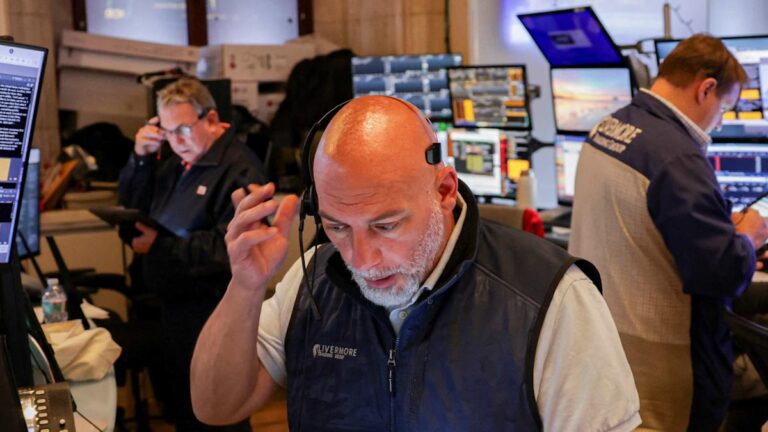00:00 Speaker A
US stocks pause their recent rally as investors digest softer than expected inflation and assess US China trade talks. Yahoo finance’s Josh Schafer joins us now with the trading day takeaways. Josh.
00:14 Josh Schafer
Hey Josh. So it wasn’t the most exciting trading day by the time we got to the close, right? So I’ll just highlight where markets ended because I personally got a little bit of a kick out of this. The Dow Jones Industrial Average falling just one single point today. Not something you see very much, but I do think we got a little bit of insight Josh into the shifting market narrative that you and I have been talking a bit about. So I want to go back to S&P 500 futures and take a look at the early morning action. So this morning you had sort of rumors of a US China deal being agreed to, right? Right around here is when President Trump posted on Truth Social that there is a deal. It just hasn’t been signed yet. There are some things to iron out, right? Right. Going back a month and a half ago, that’s market-moving news, right? But notice futures didn’t really move, but then they did. But what happened here? Inflation data. Inflation data came in better than expected and to me and some strategists on Wall Street that we’ve been speaking with over the last two weeks sort of feeds the narrative that trade talks are not what is going to move the market its next leg higher, right? We’re starting to get back to the data here. People want to know how tariffs are impacting the data, and quite frankly, the data in May, when there were tariffs in place was pretty good, right? So what you’re looking at here is CPI, and if we look at that three-month annualized, so the last three months, that’s in green here. Actually, below the Fed’s 2% target. So overall a pretty solid May inflation report didn’t give stocks enough to close higher on the day, but you did see some reaction there where it’s, okay, we’re starting to look at data. Not just following Truth Social and what’s coming out from from that social media.
02:46 Speaker A
It was just that. So what do we make of? So the president goes on social media Josh, and he says, okay, we got in the US and China, got this new effort, I got a new framework, get back to negotiations. What do you make of the market reaction or non-reaction? Does it tell you, well, actually, maybe a lot of that was already priced in?
03:20 Josh Schafer
Yeah. I mean, think about how far we’ve come, right? The S&P 500 is up about 20% or maybe a little bit more than that since those April 9th lows, April 8th lows, right? We priced in good outcomes, I think at this point, right? When all these S&P 500 target upgrades we’ve been talking about, right? We had city earlier this week. You had a slew of them over the past two weeks. All of those include baseline tariffs that are pretty high, maybe at the level that we’re looking at right now at about 15%. You guys are just talking to Deutsche Bank’s Pinky Chatta. He’s got a 6,550 call in the S&P. He’s not saying tariffs are going away. It’s maybe we know how to manage these tariffs, right? Maybe we can survive with tariffs. So that means incremental news on deals isn’t really going to move the meter. The question is where the economy’s at. It is inflation going to tick back up like some people expect, is the unemployment rate going to tick back up? Those are the big questions right now, not necessarily, when is this exact deal coming? What are the minor details? I think the market has started to just accept the tariffs are here to stay.
04:57 Speaker A
All right, Schafer, bullet point number two.
05:01 Josh Schafer
So this was an interesting point from Bank of America’s team of economists. They said that the odds of good cuts from the Fed might be building. So you had that strong jobs report last Friday or at least decent jobs report, right? You have inflation falling. They’re arguing that the two rate cuts that we have priced in. So let’s find our June 11th forecast right here. Two interest rate cuts from the Fed, you can see less than we had been pricing, right? In March and in April. But those were the bad cuts. That means the Fed’s cutting because the economy is slowing, right? That was when we were worried about tariffs weighing on the overall US economy. Now, when you look at these two cuts, Josh, it’s maybe because inflation’s falling. And so if the Fed is able to cut because inflation is falling and not cutting to save the economy because the labor market is deteriorating, that’s probably a relatively bullish sign for stocks.
06:23 Speaker A
And what do we think we actually see and hear from the Fed next week?
06:29 Josh Schafer
Yeah. I mean, at this point, markets have essentially priced in almost 100% chance that the Fed doesn’t move, right? It’s going to be another meeting where you’re sort of waiting to hear what Powell says. Other interesting thing to point out though is we talk about these two cuts that markets are expecting next week. We will get an updated summary of economic projections where we get a median dot plot point on interest rates and where the Fed sees policy at the end of the year. So markets pricing two, if you get zero or one, maybe that’s a headwind for stocks. That’s definitely going to be a big point of conversation next week.
07:15 Speaker A
All right. Thank you, Josh. Appreciate it.
